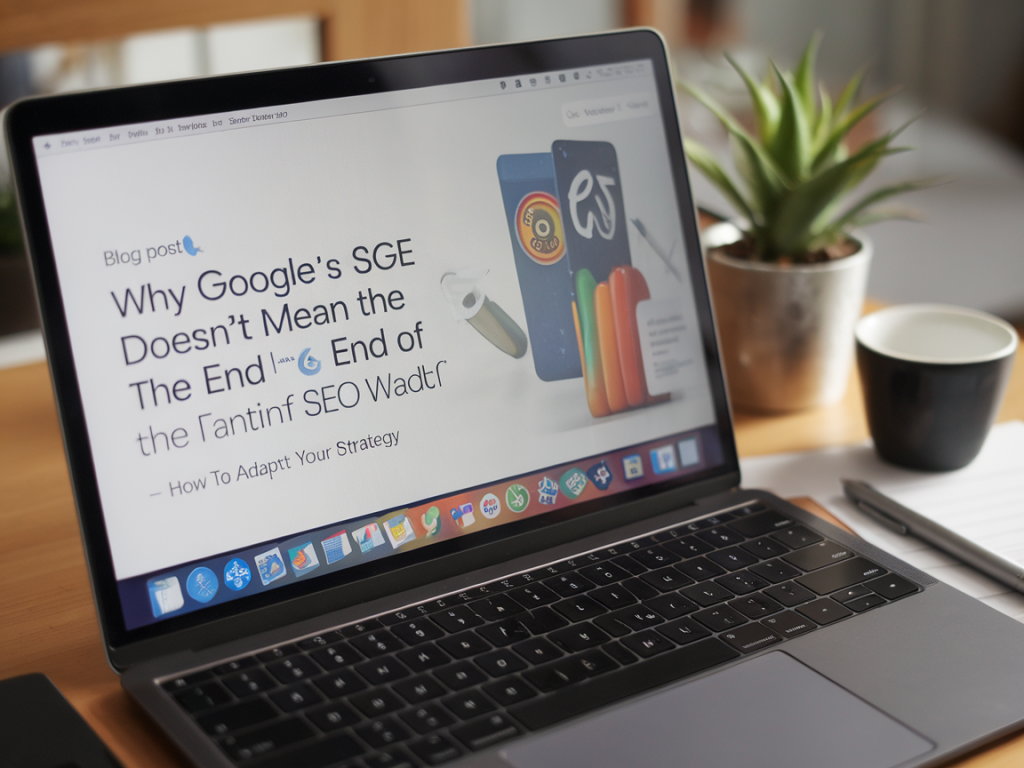
Over the past few months, I’ve received an increasing number of emails and messages asking the same urgent question: “Is Google’s Search Generative Experience (SGE) going to kill SEO?” It’s a valid concern. As an SEO strategist who has witnessed first-hand the turbulence caused by algorithm updates, new SERP features, and AI-powered tools, I completely understand the anxiety. The truth is — no, SGE doesn’t spell the end of SEO. But it does mark the beginning of a major evolution, and it’s one that we need to adapt to wisely and strategically.
What is Google's SGE, and why is everyone talking about it?
In case you haven’t been keeping track, Google rolled out its experimental Search Generative Experience under the Search Labs initiative. SGE leverages generative AI to deliver detailed, conversational answers directly within search results — not as standalone snippets or links, but as dynamic, AI-generated overviews answering user queries at a glance.
Picture this: Instead of ten blue links and a few ads, users might now see a block of text, summarizing responses pulled from across the web with references to sources (occasionally), followed by traditional results. SEO professionals are rightly asking: “If Google gives users everything they need in a generated summary, why would anyone click through to our content?”
SGE might change the rules, but the game is still on
Here’s the thing — Google’s mission hasn’t changed. It's still about connecting users with the most relevant, high-quality content. SGE is just a new way of surfacing that content. It doesn’t generate knowledge from the ether; it pulls from existing pages across the web — pages like yours and mine.
The goal for us as SEO professionals is no longer limited to ranking #1. It’s about being referenced by the AI-generated answers, earning trust, and transforming intent into action further down the funnel. If anything, the introduction of SGE should inspire us to get more strategic, not throw in the towel.
How to position your content to thrive with SGE
Let’s cut to the chase. If SEO is not dead, then how do we navigate this new terrain without getting buried under AI-generated summaries?
Focus on topical authority
SGE favors content from websites that demonstrate deep expertise on a particular subject. Building topical authority means:
- Creating comprehensive content clusters and internal linking structures
- Covering your niche from multiple angles: how-to guides, case studies, glossary pages, FAQs, etc.
- Updating your content regularly to reflect the latest changes and statistics
The days of one-and-done blog posts are over. We’re now in the era of content ecosystems, not just content hubs.
Structure your content for AI readability
SGE reads your content differently than traditional SERP crawlers. It parses natural language more deeply, looking for clarity, structure, expertise, and support data. Here’s how to give your content an AI-friendly makeover:
- Use subheadings with clear intent (H2s and H3s that reflect search questions)
- Add bulleted or numbered lists to break down complex ideas
- Incorporate data, quotes from experts, and original insights
- Use schema markup (FAQ, HowTo, Article) to improve discoverability
Double down on unique value
If generative AI provides quick answers, your content must go beyond that. Offer what AI can’t — personal experiences, nuanced opinions, proprietary data, expert interviews, and community insights. This is why I advocate for producing content that’s not just optimized, but deeply authentic.
For instance, when I recently tested SGE with a query about “how to create a multilingual SEO strategy,” the AI-generated summary hit basic points, but missed essential nuances like hreflang implementation in subdomain scenarios. That’s your cue: fill in what the AI misses.
Will SGE drive less traffic? Possibly — but it’s the right traffic that matters
Yes, the click-through rate for some informational queries could drop. But that doesn’t mean your traffic — or more importantly, your conversions — will plummet.
Instead of chasing vanity metrics, smart marketers should shift their focus to:
- User engagement: Are readers scrolling, clicking, filling forms, subscribing?
- Conversion tracking: Are traffic sources still delivering actionable leads or sales?
- Brand visibility in AI responses: Is your name or domain being mentioned in SGE answers?
Use tools like Google Search Console (and soon, Search Labs if Google expands available analytics) to monitor shifts in impressions and traffic. Adapt your KPIs to align with the AI-first landscape.
SGE makes E-E-A-T even more crucial
If you’ve followed Google's communications over the past year, you’re probably familiar with the E-E-A-T framework (Experience, Expertise, Authoritativeness, Trustworthiness). As Google relies more on AI to generate responses, the need for it to source content from credible authors and publishers becomes paramount.
Here are a few ways to amplify your E-E-A-T signals:
- Use bylines with author bios that showcase credentials and professional background
- Link to credible sources and peer-reviewed data
- Add trust indicators like certifications, testimonials, and case studies
- Strengthen your About and Contact pages for transparency
On SEO Actu, for example, I’ve made a point to clearly position myself as a subject-matter expert in digital marketing, reinforced by my decade of experience. This type of transparency pays off in both human trust and algorithmic recognition.
Product, service, and e-commerce content still reigns
One of the myths floating around is that SGE will dominate every type of query. In reality, it’s more geared toward informational intent. When it comes to commercial, navigational, or transactional queries — like “best SEO platform 2024” or “buy SEO courses online” — click-through remains essential.
Pages optimized for action — product pages, service pages, comparison tables, reviews — still hold tremendous value. In fact, your ability to blend education with promotion will determine whether SGE becomes a threat or an advantage.
This is not our first SEO mutation – and it won’t be the last
When I started in SEO, voice search was supposed to be the “next big killer of keywords.” Then it was mobile-first indexing. Then passage ranking. Now SGE. Did these changes disrupt the industry? Absolutely. But they also forced us to innovate.
The future of SEO isn’t about resisting change — it’s about anticipating it and evolving with it. Use SGE as your compass, not your enemy. Analyze its behavior, track how it references sources, and start optimizing not just for rankings, but for recognition within AI summaries.
Ultimately, the brands and creators that will thrive are those who ask themselves: “How can I add value where AI cannot?”

